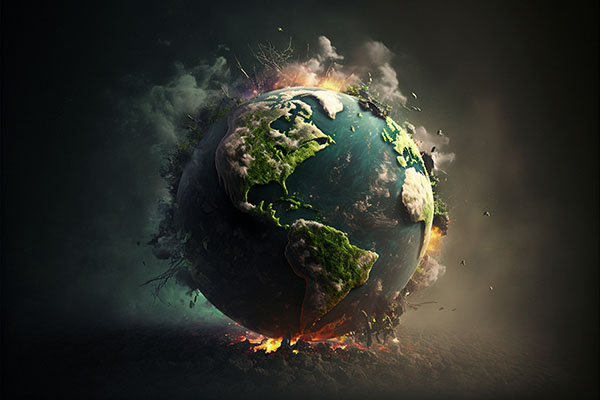
Sensors have tracked a spike in neutron emissions from a chamber known as room 305/2, which is inaccessible and has not been seen by human or robotic eyes since the explosion of Reactor No. 4 at Chernobyl on April 26, 1986.
That explosion brought down walls and sealed off many rooms and corridors. The heat generated by the explosion had melted sand from the reactor walls with concrete and steel to form lava-like and intensely radioactive substances that flowed into the reactor hall's basement rooms. These then hardened into formations called fuel-containing materials (FCMs), which are laden with about 170 tons of irradiated uranium.
Room 305/2 is thought to contain large amounts of FCMs. Scientists are now investigating whether the problem will stabilize or require a dangerous and difficult intervention to prevent a runaway nuclear reaction.
Levels of neutron emissions from the room have increased by around 40 percent since the start of 2016, which points to a growing nuclear fission reaction.
"It's like the embers in a barbecue pit," said Neil Hyatt, a nuclear materials chemist at the University of Sheffield. He added that it's a reminder to us that "it's not a problem solved, it's a problem stabilized."
Scientists are trying to determine if this surge will fizzle out, as previous spikes in other parts of the ruins have done, or whether they will need to find a way to access the room and intervene. Intervention could involve drilling into the room and spraying it with gadolinium nitrate, which would soak up excess neutrons and choke the fission reaction.
According to Hyatt, any remedy the scientists come up with will be of keen interest to Japan, which is coping with the aftermath of its own nuclear disaster 10 years ago at Fukushima. "It's a similar magnitude of hazard," Hyatt said. (Related: Radioactive fallout from Fukushima approaching same levels as Chernobyl.)
Maxim Saveliev of the Institute for Safety Problems of Nuclear Power Plants (ISPNPP) noted that the neutron counts are rising slowly, which suggests that scientists may still have a few years to figure out how to stifle the threat.
"There are many uncertainties," said Saveliev. "But we can't rule out the possibility of [an] accident."
Problem stabilized, but not solved
A year after the Chernobyl disaster, a concrete-and-steel sarcophagus called the Shelter was erected to house the remains of Reactor No. 4. However, the Shelter allowed rainwater to seep in.
Because water slows or moderates neutrons and thus enhances their odds of striking and splitting uranium nuclei, heavy rains would sometimes send neutron counts soaring.
After rains hit the Shelter in June 1990, one scientist risked radiation exposure to venture into the damaged reactor hall. The scientist dashed in and sprayed a gadolinium nitrate solution, which absorbs neutrons, on an FCM that he and his colleagues feared might go critical.
Several years later, the plant installed gadolinium nitrate sprinklers in the Shelter's roof. But the spray cannot effectively penetrate some of the basement rooms.
Chernobyl officials thought all risks would fade when the massive New Safe Confinement (NSC) was slid over the Shelter in November 2016. The €1.5 billion ($1.81 billion) structure was meant to seal off the Shelter so it could be stabilized and eventually dismantled. Neutron counts in most areas in the Shelter have either been stable or declining since the NSC was put in place.
But they began to increase in a few spots, nearly doubling over four years in room 305/2. ISPNPP modeling suggests the drying of the fuel is somehow making neutrons more effective at splitting uranium nuclei.
"It's believable and plausible data," Hyatt said. "It's just not clear what the mechanism might be."
The threat can't be ignored. As water continues to recede, the fear is that "the fission reaction accelerates exponentially," which could lead to "an uncontrolled release of nuclear energy," Hyatt said.
Scientists say that there's no chance of a repeat of 1986, when the explosion and fire sent a radioactive cloud over Europe. A runaway fission reaction in an FCM could sputter out after heat from fission boils off the remaining water. (Related: Air pollution of cities more dangerous to health than living near Chernobyl radiation zone.)
That said, any explosive reaction could bring down unstable parts of the unsteady Shelter, filling the NSC with radioactive dust.
Cause for concern, but not alarm
Hyatt views the situation as a "cause for concern but not alarm." But if the rate of neutron production continues to increase, researchers may need to intervene.
Addressing the new threat is proving to be a daunting challenge, forcing experts to think of ideas to combat it. One idea is to develop a robot that can withstand the intense radiation for long enough to drill holes in the FCMs and insert boron cylinders, which would function like control rods and sop up neutrons.
Ukraine has long intended to remove the FCMs and store them in a geological repository. By September, with help from European Bank for Reconstruction and Development, Ukraine aims to have a comprehensive plan to do so.
Follow Nuclear.news for more news and information related to nuclear disasters.
Sources include:
Please contact us for more information.






















